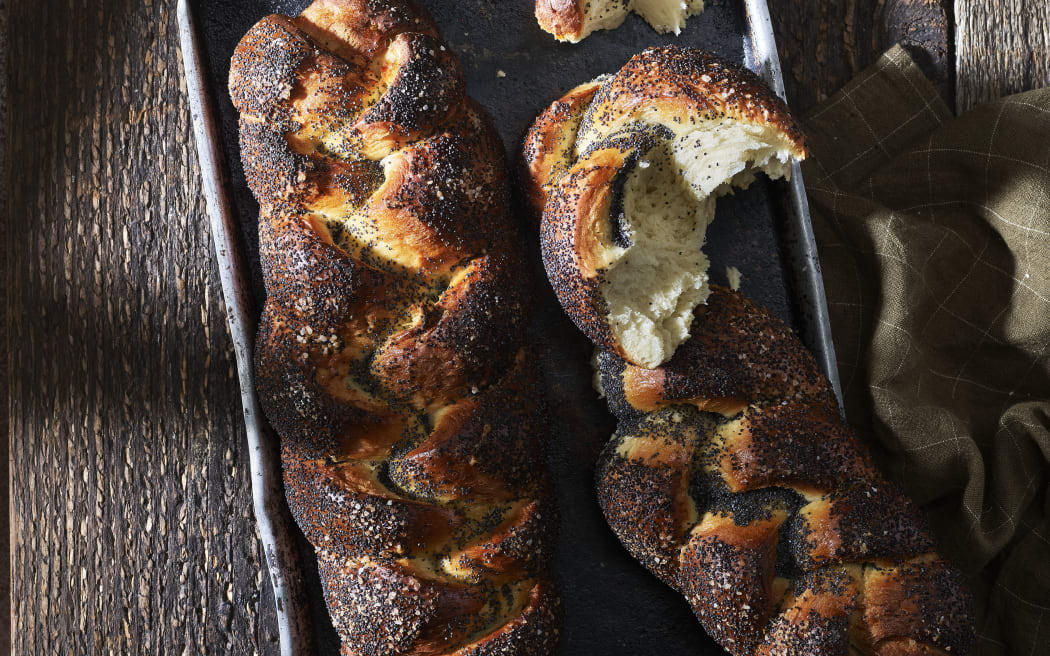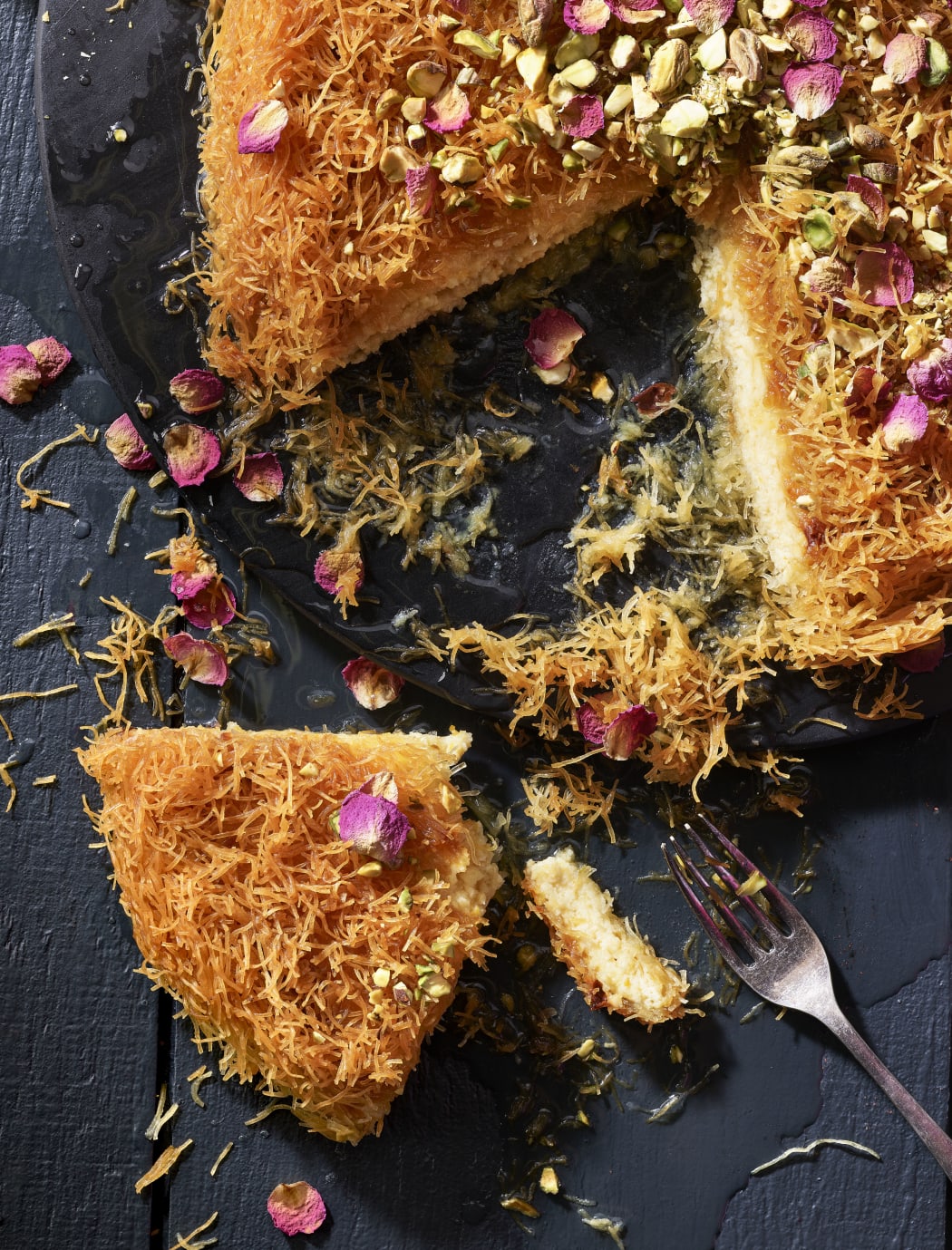Knafeh and Challah
Images and text from Butter, Butter by Petra Galler, photography by Melanie Jenkins (Flash Studios)
CHALLAH
Makes 2 loaves

"Image from Butter, Butter by Petra Galler" Photo: Melanie Jenkins (Flash Studios)
I have so many fond memories of eating challah. I went to a small Jewish primary school and every Friday we had the opportunity to buy a couple of loaves to take home to our families for Shabbat.
We never really celebrated Shabbat in our household, but we definitely celebrated bread, so every Friday without failure I would hop on the bus home with two pillowy loaves in hand. I don't think the loaves ever survived the 10-minute bus journey intact. It's almost brioche-like in sweetness, but has this gorgeous thready, pull-apart texture that makes it near impossible to resist. Once you start, it's very hard to stop, so either don't even try it, or commit to the whole loaf! I would choose the latter. The recipe below is enough for two braids and is best eaten on the day it is made. If there are leftovers however, it's divine lightly toasted with lashings of butter, or turned into French toast.
Ingredients
- 250 ml (9 fl oz/1 cup) lukewarm water
- 15 g (½ oz) instant dried yeast
- 50 g (1¾ oz) caster sugar
- 2 eggs
- 65 ml (2 fl oz) rapeseed oil
- 670 g (1 lb 7½ oz) plain flour
- ¾ tablespoon table salt
- To garnish
- 1 egg, beaten for egg wash
- poppyseeds, to garnish
- flaky salt
Method
In a small bowl, combine the water and yeast and 1 teaspoon of the sugar, stirring briefly. Allow to sit for 5-10 minutes until foaming.
In the bowl of a stand mixer, add the eggs, oil, the yeast mixture and the remaining sugar. Mix until combined. With the dough hook attachment ready to go, start mixing on a low speed while you gradually add the flour and salt. Mix for 6-8 minutes until smooth and elastic; the dough may feel slightly firmer than what you may be used to.
Shape into a ball and place in an oiled bowl, cover and allow to rise for 1-2 hours or until doubled in size.
Turn the dough out onto a lightly floured surface and dived into 6 equal balls; I sometimes weigh these out if I'm feeling pedantic.
Cover again and let rise for 10 minutes. Grease and line a large oven tray. Now we are ready to braid. Take three pieces of the dough, roll each piece out into a 40 cm (16 in) long strand and position them side by side on the prepared baking tray. Pinch the tops of the ropes together and braid, pinching them together at the bottom. Tuck the ends under on each side. Repeat this process with the remaining dough, and place on your prepared tray before covering loosely with cling film and allowing to rise for 15 minutes.
Preheat the oven to 170°C (325°F) fan-bake.
Brush each loaf all over with egg wash and sprinkle generously with poppy seeds and flaky salt.
Bake for about 35-40 minutes or until the loaves are a deep brown colour and hollow sounding when tapped. Set aside to cool momentarily before tearing and sharing.
KNAFEH
Serves 10

'Image from Butter, Butter by Petra Galler" Photo: Melanie Jenkins (Flash Studios)
On a family trip around Israel, Palestine and Jordan I think I ate my weight in knafeh. Actually, I know I did. But it wasn't until our last stop in Amman when Nirvana was really reached. I had heard of the hole in the wall, Habibah, and it turned out to be a mere 100 metres from our hotel, easily spotted by the hordes of people streaming from the tiny alleyway holding plates of pistachio-bejewelled, syrupy heaven. I have forced this dish on a fair few sceptics and every time it has been met with surprised delight. Kataifi pastry, popular throughout the Middle East and Mediterranean, is a threadlike dough, and is often referred to as 'shredded filo dough' although that is not technically accurate. Unlike filo, kataifi starts as a crêpe-like batter, which is dripped into a rotating metal plate with fine spouts. The long strands are spun out, briefly dried and cooked until you are left with vermicelli-like strings. You will find kataifi pastry at Middle Eastern and Mediterranean grocers in the freezer section. It's crunchy, cheesy, sweet and sticky and may make little sense on paper but I implore you to try this recipe - you won't be sorry.
Ingredients
- 245 ml (8½ fl oz) water
- 400 g (14 oz) caster sugar
- 3 tablespoons lemon juice
- 1½ tablespoons orange blossom water
- 275 g (9¾ oz) kataifi pastry, defrosted
- 200 g (7 oz) butter, melted, plus extra for greasing
- 200 g (7 oz) grated mozzarella
- 200 g (7 oz) ricotta
- 200 g (7 oz) feta, crumbled
- 30 g (1 oz) caster sugar
- zest of 2 oranges
- zest of 1 lemon
- ½ teaspoon sea salt
- 1 teaspoon orange blossom water
- 50 g (1¾ oz) pistachio nuts, finely chopped
- 2-3 tablespoons dried rose petals, to garnish
Method
For the Sugar Syrup, combine the water and sugar in a medium pot and bring to the boil over a medium heat, stirring continuously until the sugar has completely dissolved.
Remove from the heat and stir in the lemon juice and orange blossom water. Set aside until cool.
Preheat the oven to 175°C (335°F) fan-bake. Generously grease a 30 cm (12 in) cast iron skillet or baking dish. Make sure you get every little corner here - nothing is more heartbreaking than a stuck knafeh.
Using kitchen scissors, roughly cut the kataifi pastry until the strands are a couple of centimetres long. Place in a large bowl and pour over the butter, tossing to ensure every strand is covered. This looks like an alarming amount of butter I know, but trust the process!
Place three-quarters of the pastry into the greased dish and press into the base and up the sides. You want to be quite firm here, almost like you are lining a tart tin with pastry. You are making the shell and you want it to be firm and compacted.
In a separate bowl, stir the cheeses, sugar, zests, salt and orange blossom water together until combined and then spread on top of the pastry base in an even layer.
Top the cheese with the remaining pastry, pressing down firmly again; be mindful to cover every bit of the cheese filling.
Place a piece of baking paper on top and then rest another dish about the same size on top so the knafeh is compressed.
Bake for 30-35 minutes and then remove the dish and baking paper and bake for a further 25-30 minutes until the top is golden brown and crisp.
Remove from the oven and allow to cool for 5 minutes before gently running a knife around the side of the dish.
Flip onto a platter; preferably one with sides so you avoid losing any precious syrup! You want to be brave and bold when flipping the knafeh.
Drizzle the cooled syrup all over, and allow it to soak in for 5 minutes before adorning with chopped pistachios and dried rose petals.
I absolutely insist you eat this warm.